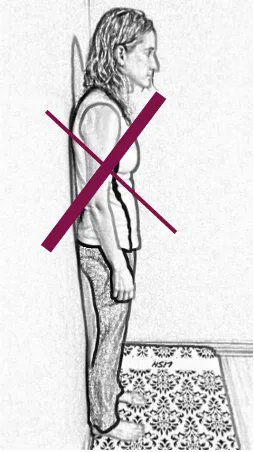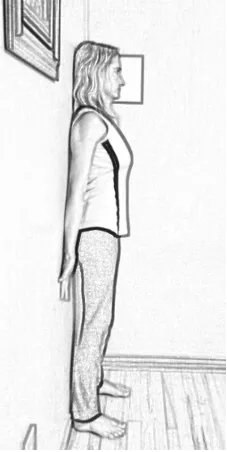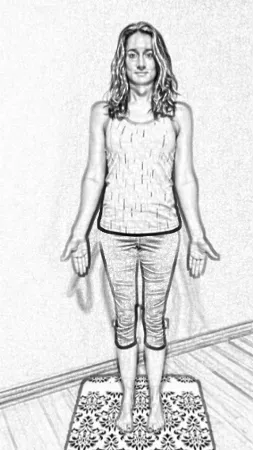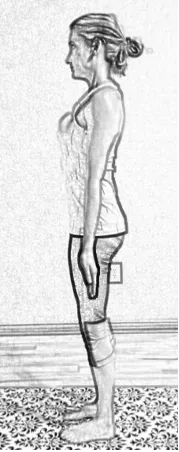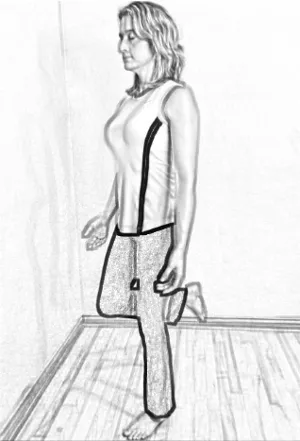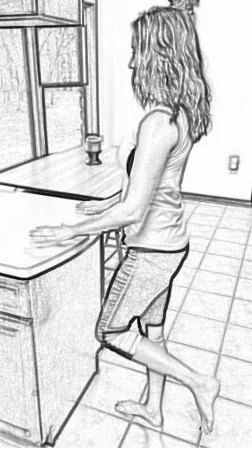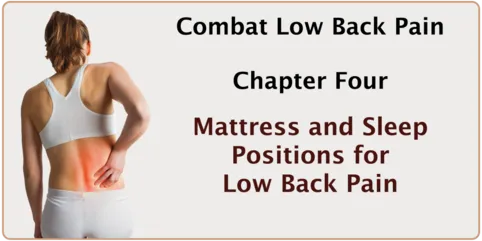Posture is something most people don’t think about until they feel uncomfortable when standing or sitting. But how you hold your body in these two common positions can affect your muscles.
Most people slouch (figure below), causing the pectoral muscles (those in your chest) to tighten and the abdominal and back muscles to weaken. This leads to low back pain.
Poor posture results in tight pectoral and low back muscles (thick line) and weak mid-back and abdominal muscles (thin line).
You can begin to alleviate low back pain by stretching the trapezius muscles, the gluteal muscles, and the pectoral muscles. Strengthening the abdominal muscles and the rhomboid muscles will also help relieve low back pain. (See Chapter 2 for more on these muscles.)
The more flexible your spine is, the easier it is to stand up straight and tall. Strong mid-back and abdominal muscles and looser pectoral and low back muscles also contribute to good posture.
Many of my patients’ low back pain resolves when they avoid sitting too much and maintain better posture when they sit and stand. If you think sitting too much at work is contributing to your back pain, check out Top Seven Ways to Combat the Effects of Sitting: The Silent Killer. In that book, I explain what proper posture is when sitting at a desk, how to maintain good posture throughout the day, and more.
To ease some of the pain that comes from sitting too much, get up every hour to stretch and go for a little walk. Every muscle in your body will benefit.
A Simple Posture Check
An easy way to check your posture is to stand against a wall and see if you can touch the back of your heels, buttocks, shoulders, and head to the wall (figure below).
Figure 3‑2: Checking posture against a wall.
If you cannot easily do this, check out my book Combat Slouching to learn how you can not only prevent your posture from worsening over time, but improve it.
Throughout the day, check your posture. Once you have mastered standing up straight against a wall, try doing it away from the wall. In yoga, we call this mountain pose.
Mountain Pose
To do the mountain pose, plant your feet hip width apart, with your weight evenly distributed between your forefoot and heels. Then check your plumb line, making sure your ears are over your shoulders, your shoulders are over your hips, and your hips are over your knees and ankles (Figure 3-3).
Figure 3‑3: Practice the mountain pose to improve your posture.
Check how your feet are planted on the mat. Make sure your toes are spread apart and you can feel your heels pressing evenly to the ground. The front of your feet should press down at the base of both your big and little toes. This triangular pattern of weight bearing is important for stabilization of the pose.
Once you feel like you have found your best alignment, hold it for a few seconds before working on the following poses that test and exercise your proprioception.
Proprioception
Your low back pain can be a result of poor proprioception.
After any injury, the body is not quite the same, no matter how minor the injury. I always have my patients check their proprioception (the awareness of your body in space without using your vision or inner ears).
You can test your proprioception by standing on one foot and closing your eyes (Figure 3-4). When your eyes are closed, you can’t rely on your vision to tell you where you are in space. Because you are not moving, your inner ears can’t help you either. You are relying solely on your proprioception.
Figure to the left: Testing my proprioception.
If any bone in your body is misaligned, you will have a difficult time standing on one foot with your eyes closed because your brain automatically sends signals to your muscles to make minor adjustments to keep your body upright. If your body isn’t aligned as your brain expects, the muscle corrections will be incorrect and you will start wobbling.
In addition to relying on your vision to tell you where you are in your surroundings, you have mechanisms in your inner ears that tell your brain how you are moving. Nerve fibers throughout your body give your brain even more input as to where you are in space.
If you can’t stand on one leg with your eyes closed for more than thirty seconds (three minutes on a wobble board if you participate in athletics), then you are more prone to injuries because you are visually dependent for your balance. If you get visually distracted for a short period of time, you will likely misjudge where you are in space and potentially get hurt (misplace your foot and roll your ankle for example).
Most people lose their balance as they age. I attribute this to the fact that many people do not exercise their balance. How often do you stand on one foot with your eyes closed? If you don’t use it, you lose it.
Proprioception Exercise
To exercise your body’s proprioception, you need to remove two indicators of your body’s position: sight and detection of movement by your inner ears. You can do this by closing your eyes (to remove the visual reference) and standing still on one leg (without movement, your inner ears aren’t much assistance).
You should do this by a wall or with your hands hovering over a counter so you can prevent yourself from falling if you start to wobble too much (Figure to the left).
You should be able to do this for at least thirty seconds per leg (three minutes if you are an athlete). If you cannot, then you are vulnerable to injury if you get visually distracted and misstep. Good proprioception allows you to catch yourself from falling, making you less likely to twist an ankle (or, when you’re elderly, break a bone). If you don’t practice your proprioception, you are more likely to fall, resulting in injury.
Figure to the left: Working on proprioception by standing on one leg with my eyes closed and my hands hovering over a countertop.
Everyone should do this exercise every day. People sit too much, often with poor posture. If you don’t fight the effects of sitting, you become more bent and stiff with time. Your brain doesn’t notice this slow process, and when you reach that tipping point, you start misjudging where you are in space to such a degree that you become clumsy. I have had patients who started having multiple falls in situations where they shouldn’t, for example, when going from carpets to hard flooring. Once they worked on their proprioception, they didn’t fall as often (if at all).
To learn more about how we treat here at Drummond Chiropractic, CLICK HERE.
To go back to our home page, CLICK HERE.
Drummond Chiropractic,
Your Downtown Bloomington Low Back Pain Specialists
565 N Walnut St
Bloomington, IN 47404
(812) 336 - 2423

